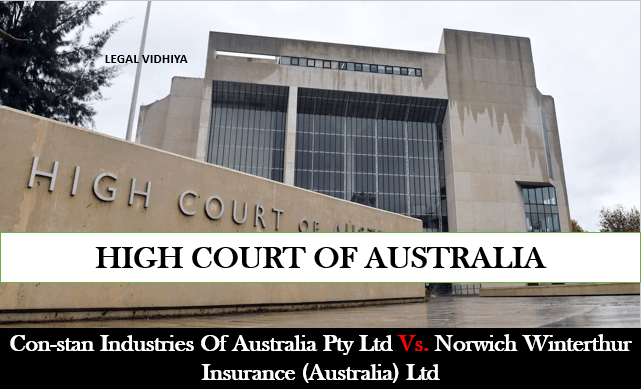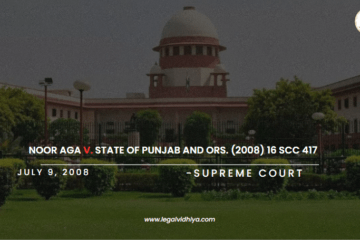
| CITATION | 160 CLR 226 |
| DATE OF JUDGMENT | 11th April 1986 |
| COURT | High Court of Australia |
| APPELLANT | Con-Stan Industries of Australia |
| RESPONDENT | Norwich Winterthur Insurance |
| BENCH | Gibbs C.J., Mason, Wilson, Brennan and Dawson JJ. |
INTRODUCTION
On June 29, 1978, Norwich submitted a winding-up order to Bedford, and it was granted on September 20, 1978. In 1981, Norwich initiated legal proceedings to recover premiums from Con-Stan in the NSW Supreme Court. Judge Rogers ruled that an insurer couldn’t seek recourse against an assured if the assured had paid premiums to the broker who arranged the insurance.
In 1983, the Court of Appeal, in a majority decision, overturned the judgment. Judges Glass and Mahoney held that the implied terms couldn’t be enforced as they couldn’t be clearly defined to establish the parties’ rights and didn’t meet the business efficiency test. They found no evidence that Norwich would have considered these terms obvious. In contrast, Judge Hutley, in his dissenting opinion, believed that Con-Stan and Norwich had a contract based on the implied term. He noted that if this term didn’t exist, Con-Stan might have acted differently, such as paying the broker directly or insisting on the broker maintaining a trust account. In 1986, Con-Stan appealed to the High Court with special leave, arguing that there was an implied term in the insurance contract, either by custom or usage, making Bedford solely liable to Norwich for premium payment or that paying the premium to Bedford relieved the assured’s obligation to Norwich.
FACTS OF THE CASE
- The 1986 case of Con-stan Industries of Australia Pty Ltd v. Norwich Winterthur Insurance (Australia) Ltd centered on the legal dynamics among three entities: an insurer (Norwich Winterthur Insurance), an assured (Con-Stan Industries of Australia), and an insurance broker (Bedford Insurances).
- In 1976, Con-Stan enlisted Bedford as its insurance broker to obtain insurance suitable for its overall business needs.
- Towards the end of 1977, Con-Stan approached Bedford for insurance covering various risks, including motor vehicles, workers’ compensation, and manufacturer’s output. Although Con-Stan paid premiums to Bedford, Bedford failed to transmit them to Norwich.
- Bedford faced liquidation, prompting Norwich to sue Con-Stan to recover the unpaid premiums. The central question at hand was whether an insurer could seek reimbursement for outstanding premiums from an assured who had already paid them to their insurance broker, but the broker had neglected to pass them on to the insurer. The appeal aimed to determine if a similar principle extended to general non-maritime insurance.
ISSUES RAISED
- Whether the business practice regarding the payment of insurance premiums suggest the existence of a contractual provision holding brokers responsible for remitting the premiums to the insurer?
- Whether is it implied, for the sake of business efficiency, that there is a contractual term specifying that brokers, rather than the insured party, are obligated to make the premium payments?
CONTENTIONS OF APPELLANT
- Con-Stan put forth the argument that the implied term, asserting the sole liability of a broker to an insurer for premium payment, originated from established customs or practices within the industry.
- They contended that this implied term was indispensable for ensuring the operational effectiveness of business transactions.
- Additionally, Con-Stan asserted that the recognition of a custom or usage, justifying the implication of a contractual term, is a matter grounded in factual evidence.
- They emphasized the necessity for providing proof that the purported custom is widely acknowledged and accepted to such an extent that any party entering into a contract under similar circumstances can reasonably be assumed to have incorporated that specific term into the agreement.
CONTENTIONS OF REPONDENT
- Norwich Winterthur Insurance firmly upheld its position, asserting that Con-Stan bore responsibility for the outstanding premiums.
- They put forth the argument that the introduction of a term into a contract, grounded in custom, would be inappropriate if it contradicted the explicitly stated terms within the agreement.
- Furthermore, Norwich argued that an individual could be held accountable for adhering to a custom even in cases where they lacked awareness or knowledge of its existence.
JUDGEMENT
To establish the existence of a customary practice where a broker assumes exclusive liability for remitting insurance premiums to an insurer, it is insufficient to merely show the common practice of brokers making premium payments to insurers or the fact that insurers, when faced with a broker’s non-payment, initially seek payment from the broker. Both situations are consistent with the ongoing responsibility of the assured. What is crucial is the demonstration of a consistent pattern in which insurers consistently refrain from seeking direct payment from the assured for the premium. The implication of a contractual term requires a well-established and universally recognized custom that all parties to the agreement would acknowledge. Parties entering into a contract should not presume that ambiguous or uncertain terms will be automatically inferred into the agreement. In cases of uncertainty about term implication, it is advisable to explicitly include the term in the agreement. This can be supported by showing either the absence of claims by insurers against the insured or the consistent practice of directing claims exclusively to brokers, a practice rarely deviated from.
ANALYSIS
There existed no implicit provision in the agreement, derived from established custom or common practice in the insurance sector, indicating that sole liability for premium payment rested with the broker or that settling premiums with a broker absolved the insured party of their obligation to the insurer. The asserted custom lacked universal acknowledgment and acceptance among all participants entering into insurance contracts. The absence of an implied term for business efficiency was evident as the purported implied term was not apparent to the involved parties, and there was no clarity that both parties would have mutually agreed to incorporate such a term into the contract.
CONCLUSION
In this instance, the High Court of Australia concluded that an insurance provider has the right to seek reimbursement for outstanding premiums from an insured party who has already made payment to their insurance broker, provided that the broker fails to transmit those premiums to the insurer. The court determined that there was no implicit term within the insurance contract stipulating that Con-Stan was solely obligated to remit premiums to the broker, and discharging the debt for the insurance premiums by paying the broker. The court underscored that the implication of such a term is impermissible if it contradicts the expressly stated terms of the agreement.
As a result, the court ruled in favor of Norwich Winterthur Insurance (Australia) Ltd, permitting them to recover the unpaid premiums from Con-Stan Industries of Australia Pty Ltd. The initial decision favouring Con-Stan was overturned by the Court of Appeal. This legal precedent established by the case holds significant implications in the realm of insurance law, particularly in defining the roles and obligations of insurance brokers.
REFERENCES
- https://www.hcourt.gov.au/assets/publications/judgments/1986/013–CON-STAN_INDUSTRIES_OF_AUSTRALIA_PTY._LTD._v._NORWICH_WINTERTHUR_INSURANCE_(AUSTRALIA)_LTD.–(1986)_160_CLR_226.html
- https://www.doddaccounting.com/blog/critical-case-summary-of-con-stan-industries-of-australia-pty-ltd-v-norwich-winterthur-insurance-australia-ltd-1986-160-clr-226
- https://jade.io/article/67260
This Article is written by Soumya Saisa Das student at Amity Law School, Noida (ALSN); Intern at Legal Vidhiya.
Disclaimer: The materials provided herein are intended solely for informational purposes. Accessing or using the site or the materials does not establish an attorney-client relationship. The information presented on this site is not to be construed as legal or professional advice, and it should not be relied upon for such purposes or used as a substitute for advice from a licensed attorney in your state. Additionally, the viewpoint presented by the author is of a personal nature.




0 Comments